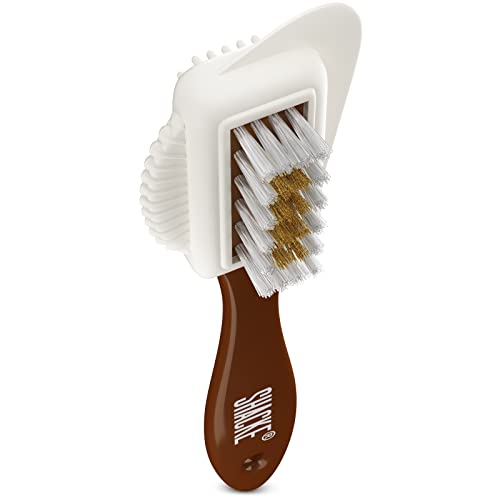Suede shoes are essential for any closet. They have a unique texture and can be worn with a wide variety of outfits. They are also extremely lightweight and can even be worn in the summers.
But there’s a major problem with suede shoes – mold.
Mold can effectively ruin your experience of wearing suede shoes, and it leaves a bad taste in the mouth of anyone who sees such a piece of footwear.
Thankfully, removing mold from suede shoes is not that difficult. If you follow the step-by-step process I outline in this guide, cleaning moldy suede shoes is going to be a super easy process for you.
Let’s begin!
How To Remove Mold From Suede Shoes?
Removing mildew from suede can be a tiresome process, but the rewards that come with it are immense. People just throw away their shoes when they see signs of mold on them, but it doesn’t have to be that way.
Here’s a step-by-step process to remove mold from suede shoes.
1. Prepare for the mold removal process
Before you do anything else, you need to do some preparations so that the entire process runs smoothly and you don’t run into any trouble.
Firstly, go out into your backyard with your suede shoes and set up your workstation in an area that gets a lot of sunshine. Sunshine is a natural mildew killer.
It’s important that you do everything outside because otherwise, you will risk the spread of mold spores inside your home.
Wear a mask and (preferably) rubber gloves. This will help in preventing the spores from entering your mouth or nostrils.
2. Use a suede brush
A suede brush is simply a brush that has been made specifically for fixing the fibers of suede. They are pretty cheap, and I recently wrote an entire guide about the best suede cleaning products that includes a lot of affordable options.
- Classic Suede Brush & Nubuck Cleaner – Hands down the most effective suede brush on the...
- No Added Solutions or Other Brushes Needed – Although protective spray is encouraged,...
- The Best for Removing Heavy Dirt and Scuff marks – Regular brushes just spreads dirt...
- Work Your Way into all Corners of Your Shoes – With three built in rubber brush (Rubber...
A lot of spores would fall down if you just brush them properly. Remember to not go too hard on the affected areas, as that can pull out suede fibers which is something that we definitely don’t want.
Brush until all the majorly affected spots are clean. Don’t worry about the stubborn finer pieces of mildew, as we will take care of them in the next steps.
3. Coat the affected areas with petroleum jelly
Identify the mold that still sits on your shoes and rub a light layer of petroleum jelly over it. Let the suede absorb the petroleum jelly. This should take about 10-15 minutes depending upon the size of the affected area.
This will do two things. First, petroleum jelly by itself has properties that can help in fighting against mold. Secondly, the coating is going to protect suede fibers from the water and rubbing alcohol solution we are going to be using in the next step.
NOTE: Please do a spot test before you apply vaseline to your shoes. Depending upon the suede fibers, doing so can lead to darkening and discoloration. Therefore, it would be better if you check the product in an inconspicuous spot first.
4. Apply some rubbing alcohol over the mold
Rubbing alcohol (and alcohol in general) has disinfectant properties and thus it forms an effective tool in getting rid of mold.
To dilute the rubbing alcohol, mix it with some water. We want the solution to be equal parts water and rubbing alcohol, preferably two tablespoons of each. Dip a cotton swab into this mixture and start applying it to the mold.
The petroleum jelly (which shouldn’t be visible at this point) absorbed by the suede fibers is going to help in protecting the fibers against water.
It is important to be careful when doing this because we don’t want the solution going anywhere that it doesn’t need to go. If you don’t know, suede and water do not get along with each other.
5. Apply the finishing touches
Let the rubbing alcohol and water solution sit on the mold for some time, but we don’t want it completely absorbed. About 3-5 minutes is fine in most cases.
Now use a microfiber cloth to wipe away the solution. You will notice that the smaller and more stubborn pieces of mold are also wiped along with it. Your shoes are finally free of mold.
Use your suede brush once again to get rid of anything remaining on the surface of the shoe. Make sure that you are running the brush in the direction of the suede fibers.
This will ensure the proper flow of suede. After brushing it thoroughly, let the shoes sit in the sun for a couple of hours.
And by the end of this process, your suede shoes are going to be completely free of mold.
Can You Get Rid Of Mold Through Vinegar?
Yes, vinegar can get rid of mold on suede but it will change the color of your shoes. That’s why it’s much better to avoid vinegar in the cleaning process.
When it comes to vinegar, the cons outweigh the pros. Using vinegar would lead to intense discoloration on your shoes, and it will also make your entire shoe smell like vinegar.
But if you don’t care about any of that, then you can just replace the rubbing alcohol solution in the above process with vinegar, and it will lead to pretty much the same results.
However, do this only if everything else fails.
Do not use bleach
While bleach might be a great option for your clothes, it is not a good idea to use bleach on your suede shoes, especially if you want to remove mildew from them.
Using bleach will lead to discoloration of suede, and will effectively kill the texture of your shoes as it will flatten the nap.
The cons of using bleach heavily outweigh the pros, so you should stay away from this cleaning method if you want your suede shoes to look good again.
Final Remarks
Getting rid of mold is necessary for the health and longevity of your suede shoes. In this guide, I provided you with a simple 5-step process to do this effectively:
- Prepare for the mold removal process.
- Use a suede brush to brush away the mildew spores.
- Coat the mold with a light application of petroleum jelly.
- Apply a combination of equal parts rubbing alcohol and water.
- Apply the finishing touches.

My name is Alex Higson and I am the founder of Magic Of Clothes. I have worked in the fashion industry for many years, and clothes and style are a huge part of my life.

